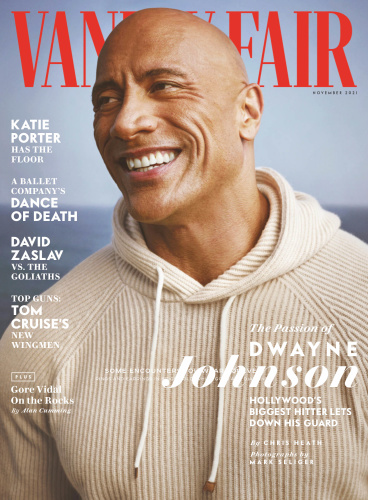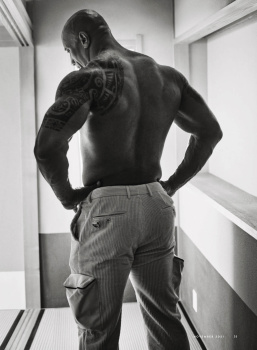-
Share with us... Your Best & Worst Collections of Haute Couture F/W 2025.26
-
Xenforo is upgrading us to version 2.3.7 on Thursday Aug 14, 2025 at 01:00 AM BST. This upgrade includes several security fixes among other improvements. Expect a temporary downtime during this process. More info here
You are using an out of date browser. It may not display this or other websites correctly.
You should upgrade or use an alternative browser.
You should upgrade or use an alternative browser.
Vanity Fair November 2021 : Dwayne Johnson by Mark Seliger
- Thread starter vogue28
- Start date
tigerrouge
Well-Known Member
- Joined
- Feb 25, 2005
- Messages
- 18,720
- Reaction score
- 9,233
As a portrait shot, it doesn't even look like him, and as a cover shot, it looks like an advert for expensive knitwear.
Mihail Mihailov
Well-Known Member
- Joined
- Aug 15, 2019
- Messages
- 142
- Reaction score
- 155
i haven't seen a single good cover for this year from this trash magazine, what a great magazine was back in the 80s,90s and early 00s , forgive me the bad language,but for f..k sake! do you see how every magazine is ruining what they established in the years before? Vogue USA, UK, Italia, Germany, RollingStone (with that lame Madonna cover) Vanity Fair with Dwayne, come on.... Harper's Bazaar too, i miss so much the work all the editors have done before
also does anyone knows is Annie Leibovitz still working for Vanity Fair?
also does anyone knows is Annie Leibovitz still working for Vanity Fair?
JPineapple
Well-Known Member
- Joined
- Jul 1, 2018
- Messages
- 2,871
- Reaction score
- 4,017
I saw this cover a few days ago in a story of CNWWN. Thought it was from Italy or France
D
Deleted member 141309
Guest
I don't understand how this guy has a career. What do people see in him.
Oh, noooo! But he is so wholesome! Just like Keanu!! And Danny DeVito!! And... And... Bob Ross!!
On a serious note, I actually 100% agree. His nickname is also quite fitting, he has the charisma of a rock.
VogueGirl8910
Well-Known Member
- Joined
- Apr 14, 2008
- Messages
- 48,339
- Reaction score
- 8,696
Looks like a Rolling Stone's cover from late 90's & early 2000's.
tigerrouge
Well-Known Member
- Joined
- Feb 25, 2005
- Messages
- 18,720
- Reaction score
- 9,233
also does anyone knows is Annie Leibovitz still working for Vanity Fair?
I was flicking through the online copy of the UK version, and half of the editor's letter was devoted to Radhika co-hosting (with Anna Wintour) a recent party to celebrate Annie's upcoming collection of photographs, Wonderland, so I was expecting to see a short article in this issue to expand on that, but no more mention. But Radhika does sign off by talking about the images we've already seen on the pages of Vanity Fair, saying: "We're excited for all the portraits yet to come."
Mihail Mihailov
Well-Known Member
- Joined
- Aug 15, 2019
- Messages
- 142
- Reaction score
- 155
thank you @tigerrouge for the reply, i do hope she still works for them and create new beautiful portraits, she need to admit this magazine is trash at the moment....
- Joined
- Jul 14, 2017
- Messages
- 14,776
- Reaction score
- 21,850
PowerDroid
Well-Known Member
- Joined
- Jul 16, 2020
- Messages
- 202
- Reaction score
- 189
LOL after all the changes this magazine went through in the last 4 years, they went back to Mark Seliger.... That's one lousy trajectory.
tigerrouge
Well-Known Member
- Joined
- Feb 25, 2005
- Messages
- 18,720
- Reaction score
- 9,233
Reading through this...
The interview with Dwayne Johnson opens with talk of his social media posts about becoming President, I wonder if that will go any better for him than the last man who talked to Vanity Fair about his presidential ambitions (Beto O'Rourke).
There's a fairly optimistic piece about David Zaslav, the man at the head of a media merger, and on the fourth page of the feature, Vanity Fair discloses its commercial connection to the situation (Advance owns Conde Nast as well as having majority shares in Discovery, the latter being one of the companies run by Zaslav).
There's a short piece about Gore Vidal taken from Alan Cumming's new memoir. People always knew Vidal could be a “bitter old queen of a certain age”, so this article by Alan on an encounter with him just sounds like an excuse to shoehorn in a mention or two that Alan Cumming is now also an author and novelist as well, don’t you know. The problem is that the piece, printed here, is being seen in isolation - you could probably read Alan's memoir and see each of his anecdotes coming together to form a merry picture of Hollywood, but Vanity Fair choosing to reprint this particular section seems like a decision to chip away at the bottom of the statue of an aged male literary figure who was lionised - and who once roamed the pages of the magazine itself.
(Look back to 2010 and you have Christopher Hitchens casting his critical eye over Gore Vidal in his Vanity Fair column, in a way that identified the man's faults in thinking, but didn't try to diminish the man himself. There is a subtle difference.)
There are the usual political articles, as long as you remember that, according to this magazine, Democrats are flawed people but still the good guys, and Republicans are flawed people but essentially monsters, and are often literally illustrated as such, just in case the articles themselves didn't make that clear.
One of the longer features in the issue was one I was most looking forward to reading - a 10+ page article about the FBI's discovery and handling of an archaeological stockpile in the private possession of a man in Indiana, which included many sets of human remains removed from burial sites around the world. But it's quite a flat retelling of the incident, which I can understand if you're trying to discuss the sensitive issue of repatriation of human remains, it's not like an art heist where you can take liberties and introduce tension into the story for effect.
The piece entitled 'A Ballet Company's Dance of Death' is the incident involving former dancer Ashley Benefield, looking the name up will give you the gist.
The interview with Dwayne Johnson opens with talk of his social media posts about becoming President, I wonder if that will go any better for him than the last man who talked to Vanity Fair about his presidential ambitions (Beto O'Rourke).
There's a fairly optimistic piece about David Zaslav, the man at the head of a media merger, and on the fourth page of the feature, Vanity Fair discloses its commercial connection to the situation (Advance owns Conde Nast as well as having majority shares in Discovery, the latter being one of the companies run by Zaslav).
There's a short piece about Gore Vidal taken from Alan Cumming's new memoir. People always knew Vidal could be a “bitter old queen of a certain age”, so this article by Alan on an encounter with him just sounds like an excuse to shoehorn in a mention or two that Alan Cumming is now also an author and novelist as well, don’t you know. The problem is that the piece, printed here, is being seen in isolation - you could probably read Alan's memoir and see each of his anecdotes coming together to form a merry picture of Hollywood, but Vanity Fair choosing to reprint this particular section seems like a decision to chip away at the bottom of the statue of an aged male literary figure who was lionised - and who once roamed the pages of the magazine itself.
(Look back to 2010 and you have Christopher Hitchens casting his critical eye over Gore Vidal in his Vanity Fair column, in a way that identified the man's faults in thinking, but didn't try to diminish the man himself. There is a subtle difference.)
There are the usual political articles, as long as you remember that, according to this magazine, Democrats are flawed people but still the good guys, and Republicans are flawed people but essentially monsters, and are often literally illustrated as such, just in case the articles themselves didn't make that clear.
One of the longer features in the issue was one I was most looking forward to reading - a 10+ page article about the FBI's discovery and handling of an archaeological stockpile in the private possession of a man in Indiana, which included many sets of human remains removed from burial sites around the world. But it's quite a flat retelling of the incident, which I can understand if you're trying to discuss the sensitive issue of repatriation of human remains, it's not like an art heist where you can take liberties and introduce tension into the story for effect.
The piece entitled 'A Ballet Company's Dance of Death' is the incident involving former dancer Ashley Benefield, looking the name up will give you the gist.
Benn98
Well-Known Member
- Joined
- Aug 6, 2014
- Messages
- 42,533
- Reaction score
- 20,640
To me, the cover looks like something done under Graydon Carter. Could be a bit zoomed out, but it looks very simple and unfussy. In fact, I'm sure Radhika and her team are doing it on purpose because whatever ideas they've tried clearly didn't work.
America is such a topsy turvy country that someone like The Rock feels he's entitled to presidential ambitions. Not sure based on what, but I suppose the article will explain. He has the money and access so I'm sure he will make it a reality.
But we all know what happened to the other guy who also announced his presidential run on the cover of VF.....
Saw this story when it broke some months ago! The 'ballerina' is a stone-cold murderess. Like that character in Gone Girl.
Plus she had ties to The Orange One, so that cancels logical thinking right out. Others have speculated that the husband was a cheater and abusive which I don't believe at all. Her story had many holes in it.
America is such a topsy turvy country that someone like The Rock feels he's entitled to presidential ambitions. Not sure based on what, but I suppose the article will explain. He has the money and access so I'm sure he will make it a reality.
But we all know what happened to the other guy who also announced his presidential run on the cover of VF.....
The piece entitled 'A Ballet Company's Dance of Death' is the incident involving former dancer Ashley Benefield, looking the name up will give you the gist.
Saw this story when it broke some months ago! The 'ballerina' is a stone-cold murderess. Like that character in Gone Girl.
Plus she had ties to The Orange One, so that cancels logical thinking right out. Others have speculated that the husband was a cheater and abusive which I don't believe at all. Her story had many holes in it.
D
Deleted member 1957
Guest
He found his niche and his fanbase loves it, IMO not everyone has to be Denzel Washington or Timothee. That said, the cover is not flattering at all, nothing works apart from the colour scheme, The editorial is interesting but too brief.
Similar Threads
- Replies
- 20
- Views
- 3K
D
- Replies
- 11
- Views
- 2K
- Replies
- 8
- Views
- 2K
- Replies
- 16
- Views
- 6K
Users who are viewing this thread
Total: 1 (members: 0, guests: 1)












